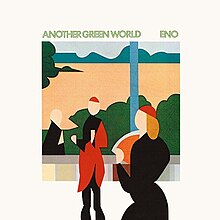| Another Green World | ||||
|---|---|---|---|---|
 | ||||
| Studio album by | ||||
| Released | 14 November 1975[1] | |||
| Recorded | July–August 1975 | |||
| Studio | Island, London | |||
| Genre | ||||
| Length | 40:55 | |||
| Label | Island | |||
| Producer |
| |||
| Eno chronology | ||||
| ||||
Another Green World is the third solo studio album by English musician Brian Eno (mononymously credited as "Eno"), released by Island Records on 14 November 1975. The album marked a transition from the rock-based music of Eno's previous releases towards his late 1970s ambient work. Only five of its fourteen tracks feature vocals, a contrast with his previous vocal albums.
Produced by Eno and Rhett Davies, it features contributions from a small core of musicians, including Robert Fripp (electric guitar), Phil Collins (drums), Percy Jones (fretless bass), and Rod Melvin (piano). John Cale plays viola on two tracks. Employing tactics derived from his Oblique Strategies cards for guidance, Eno and the backing lineup utilised a variety of unconventional recording techniques and instrumental approaches, reflected in unusual instrumental credits such as "snake guitar" and "uncertain piano". The album's cover art is a detail from British artist Tom Phillips' After Raphael.
Although the album received widespread critical acclaim, its only contemporary chart success was in New Zealand, where it reached #24. Contemporary reception has been similarly positive; several publications, including Rolling Stone, NME and Pitchfork, have named the album among the greatest of the 1970s and of all time.
- ^ "Recording News". NME. 8 November 1975. p. 2.
- ^ O'Brien, Glenn (22 November 2016). "New Again: Brian Eno". Interview. New York. Archived from the original on 22 April 2020. Retrieved 14 May 2020.